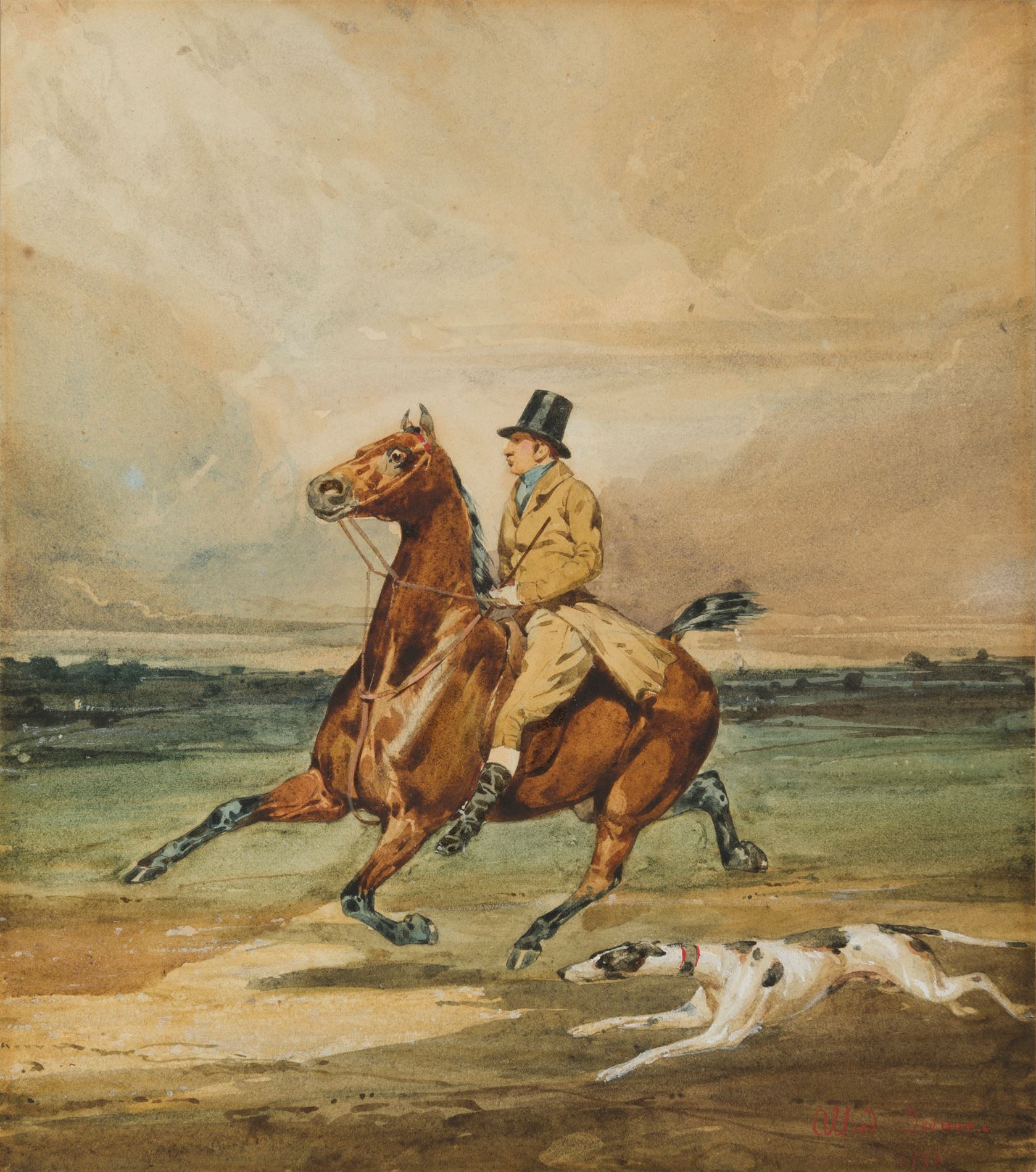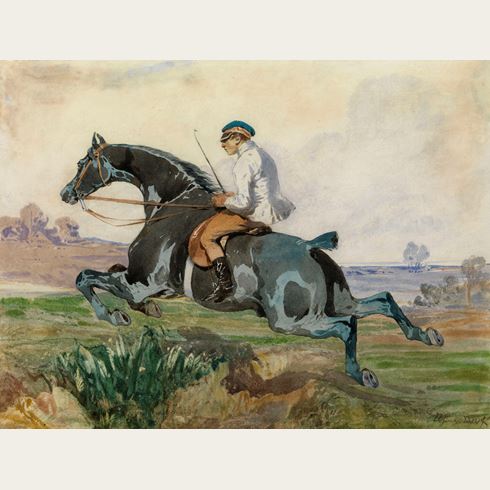Alfred DE DREUX
(Paris 1810 - Paris 1860)
A Horse and Rider with a Hound
Watercolour and gouache, laid down.
Signed and dated Alfred Dedreux / 1832 in red ink at the lower right.
213 x 186 mm. (8 3/8 x 7 1/4 in.)
Signed and dated Alfred Dedreux / 1832 in red ink at the lower right.
213 x 186 mm. (8 3/8 x 7 1/4 in.)
A splendid, fresh example of Alfred De Dreux’s watercolour technique, the present sheet is unrelated to any surviving oil painting by the artist, and is likely to have been produced as a finished work of art for a collector.
The first known owner of this watercolour was the noted 19th century French collector Alexis Hubert Rouart (1839-1911), who assembled a choice group of lithographs, paintings, drawings and watercolours, including numerous works by such artists of the Romantic period as Eugène Delacroix, François-Marius Granet, Eugène Isabey, Camille Roqueplan and others. (The present sheet does not, however, appear in the posthumous sale of paintings, drawings and watercolours from the estate of Alexis Rouart held in Paris in May 1911, although two paintings and another watercolour by De Dreux were included.) This drawing was later in the collection of the French auctioneer Michel Bivort (1904-1989).
The first known owner of this watercolour was the noted 19th century French collector Alexis Hubert Rouart (1839-1911), who assembled a choice group of lithographs, paintings, drawings and watercolours, including numerous works by such artists of the Romantic period as Eugène Delacroix, François-Marius Granet, Eugène Isabey, Camille Roqueplan and others. (The present sheet does not, however, appear in the posthumous sale of paintings, drawings and watercolours from the estate of Alexis Rouart held in Paris in May 1911, although two paintings and another watercolour by De Dreux were included.) This drawing was later in the collection of the French auctioneer Michel Bivort (1904-1989).
As a youth, Alfred De Dreux was taken by his uncle, the painter Pierre-Joseph Dedreux-Dorcy, on frequent visits to the studio of his friend Théodore Géricault. The important and formative influence of Géricault on the young De Dreux can be seen not only in the Romantic nature of his early paintings, such as the Nègre à cheval in the Vaudoyer collection, but also his lifelong fascination with equestrian subjects. After studying with Léon Cogniet, De Dreux exhibited two paintings – a Cheval sautant un fossé and an Intérieur d'écurie - at the Salon of 1831, to much acclaim. In 1833 he was commissioned to paint an equestrian portrait of the Duc d'Orléans, and by the following year was already being described by one critic as, together with Carle Vernet, ‘le meilleur peintre de chevaux de l’époque romantique.’ In 1840 he began a series of paintings entitled Portraits de chevaux, which included several depictions of horses owned by the Duc d'Orléans.
Alfred De Dreux’s depictions of horses were much admired by his contemporaries, who saw him as the natural heir to Géricault. As one critic noted in 1834, a painting of a horse by De Dreux ‘would perhaps support the comparison, in terms of its energy, its verve and its truth, with the horses of Géricault.’ In later years, Edgar Degas is known to have copied prints of horses by both De Dreux and Géricault in preparation for his own racetrack paintings.
De Dreux reached the height of his fashionable success during the reigns of Louis-Philippe and Napoleon III, and even won a commission from Queen Victoria, whom he painted riding in Windsor Park alongside the French King. (He also met Victoria’s favourite painter, Sir Edwin Landseer, who inspired him to paint dogs.) His fame was further enhanced by the lithographs after his works which were published in France, Germany, England and America. Following the abdication of Louis-Philippe in 1848, De Dreux accompanied him into exile in England. He eventually returned to France, but visited London often in later years. He received several commissions from members of the English aristocracy, for whom his paintings reflected their passion for horses, hounds and hunting. De Dreux continued to paint equestrian portraits, hunting and racing scenes throughout the Second Empire, many of which were exhibited at the Paris Salons, as well as at the Exposition Universelle of 1855. His death in 1859 remains somewhat mysterious, but was apparently the result of a duel fought over a painting.
Alfred De Dreux’s depictions of horses were much admired by his contemporaries, who saw him as the natural heir to Géricault. As one critic noted in 1834, a painting of a horse by De Dreux ‘would perhaps support the comparison, in terms of its energy, its verve and its truth, with the horses of Géricault.’ In later years, Edgar Degas is known to have copied prints of horses by both De Dreux and Géricault in preparation for his own racetrack paintings.
De Dreux reached the height of his fashionable success during the reigns of Louis-Philippe and Napoleon III, and even won a commission from Queen Victoria, whom he painted riding in Windsor Park alongside the French King. (He also met Victoria’s favourite painter, Sir Edwin Landseer, who inspired him to paint dogs.) His fame was further enhanced by the lithographs after his works which were published in France, Germany, England and America. Following the abdication of Louis-Philippe in 1848, De Dreux accompanied him into exile in England. He eventually returned to France, but visited London often in later years. He received several commissions from members of the English aristocracy, for whom his paintings reflected their passion for horses, hounds and hunting. De Dreux continued to paint equestrian portraits, hunting and racing scenes throughout the Second Empire, many of which were exhibited at the Paris Salons, as well as at the Exposition Universelle of 1855. His death in 1859 remains somewhat mysterious, but was apparently the result of a duel fought over a painting.
Provenance
Alexis Rouart, Paris, with his red wax seal (Lugt 4899) on the backing board
Michel Bivort, Paris
Private collection.
Michel Bivort, Paris
Private collection.







